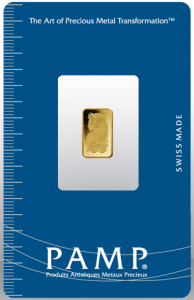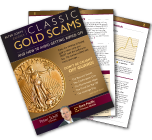One of our readers recently asked about investing in gold through a new company they had come across on the Internet. The company sells 1-gram gold ingots (tiny bullion bars) encased in thin plastic, which are stamped with a serial number and hologram to prevent counterfeiting. They tout their product as a unique development that will change the way precious metals are used in the world – but the truth is that these types of products have been around for a quite some time.
Commonly known as “ingot cards,” they are offered by internationally respected precious metals manufacturers like the Swiss gold refinery PAMP (Produits Artistiques Metaux Precieux). They issue a wide variety of them, ranging from fractions of a gram to several grams. The picture below is an example of PAMP’s 1-gram card.
Ingot cards are promoted for their anti-counterfeiting benefits, since the hologram and serial numbers are, to a certain degree, a legitimate way of proving authenticity. The cards are also sold based on their convenience to investors who cannot afford to purchase gold by the ounce, or who maybe want smaller denominations of precious metals in case of barter situations.
However, the “perks” of ingot cards come with a cost: a significant markup over the spot price of gold. At the time of this writing, the “groundbreaking” gold card product our reader asked us about was being sold at a price of more than $2,400 per ounce. That’s 40% more than spot! PAMP products are not nearly as exorbitant, but they still carry a hefty cost ranging from 12% to 27% over spot, depending on the size of the ingot. It does take more time and resources to mint smaller ingots of gold and add the protective features, most serious investors look for low premiums above all. That usually means bullion coins or bars in the highest denomination you can afford.
There are also liquidity issues. Should you be forced to sell your ingot card before the price of gold increases enough to offset the premium you paid, it’s going to be difficult to convince a buyer to give you the same premium you paid. Meanwhile, a well-known gold coins can be sold to a legitimate dealer for not too much under spot.
Also, don’t forget that the serial numbers on those ingot card can compromise your financial privacy. The retailer records which serial numbers are shipped where, and that number remains a traceable ID to whomever you sell the ingot card. By contract, a widely recognized gold coin is more anonymous than cash.
Finally, if you’re really worried about counterfeiting, you’re going to want your precious metals tested through a variety of methods: holograms, ultrasound tests, magnets, acid… to name just a few. There are a lot of ways of checking for fake gold, so don’t just trust a serial number.
Ingot gold is right for some buyers, but even they should stick to reputable manufacturers and dealers – not pushy new online multi-level marketing schemes.
Don’t be fooled by offers that claim to be revolutionizing the gold industry. The websites selling these overpriced products will cite all the legitimate reasons for investing in gold but they won’t spend nearly as much time telling you about how their niche products compare to more liquid offerings from mainstream dealers. Buying precious metals is the most simple decision you can make to ensure your financial future… don’t overcomplicate it!


